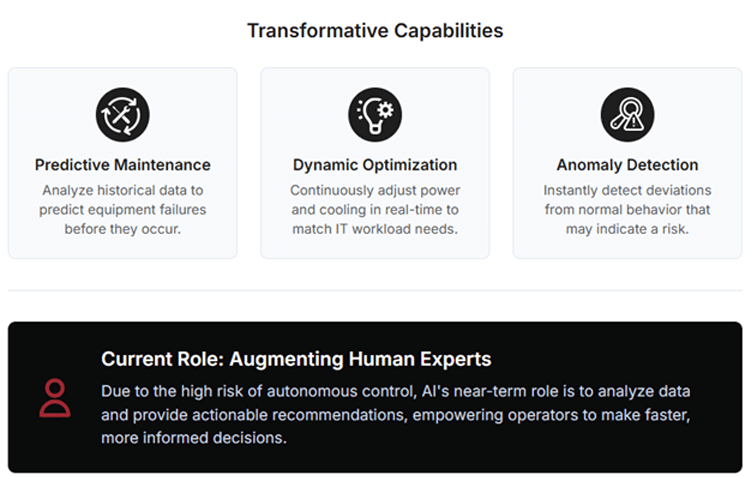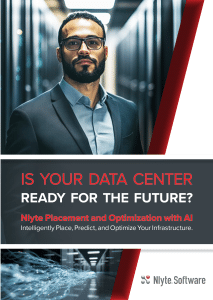AI-Powered Data Center Operations and Optimization
Published on August 22, 2025,
by
AI-Powered Data Center Operations and Optimization
Artificial Intelligence (AI) is not only transforming the way data centers are used—it’s revolutionizing how they’re managed. While AI workloads introduce unprecedented challenges in terms of power, cooling, and density, they also offer powerful tools to address these very issues. Through machine learning (ML) and intelligent automation, AI-powered data center operations are becoming essential to the future of infrastructure management.
In the context of Integrated Data Center Management (IDCM), AI plays a dual role: it drives the demand for more sophisticated infrastructure, and it provides the intelligence needed to manage that complexity. From predictive maintenance to dynamic optimization and intelligent planning, AI is reshaping how operators oversee and optimize their environments.
Predictive Maintenance: From Reactive to Proactive
One of the most impactful applications of AI in data center operations is predictive maintenance. Traditional maintenance models rely on fixed schedules or reactive responses to equipment failures. This approach can lead to unnecessary downtime, wasted resources, and increased operational risk.
With AI-powered analytics, data centers can shift to a condition-based maintenance strategy. Machine learning models analyze historical performance data from critical systems—such as chillers, UPS units, and generators—to identify patterns that precede failures. This allows operators to intervene before issues escalate, reducing downtime and extending equipment life.
In an IDCM framework, predictive maintenance becomes even more powerful. AI algorithms can correlate environmental data from Building Management Systems (BMS) with IT workload metrics from DCIM platforms, providing a holistic view of asset health and performance.
Dynamic Optimization of Power and Cooling
AI’s ability to continuously analyze and respond to changing conditions makes it ideal for optimizing power and cooling systems. Data centers hosting AI workloads often experience fluctuating demands, especially when training large models or running inference tasks. These workloads can spike power consumption and generate intense thermal loads.
Human operators cannot manually adjust systems fast enough to keep up with these changes. AI, however, can. By monitoring real-time telemetry data, AI models can dynamically adjust cooling setpoints, fan speeds, and power distribution to match workload intensity.
Google famously used machine learning to reduce the energy consumption of its cooling systems by 40%. This kind of granular, real-time optimization is now becoming more accessible to enterprise data centers through platforms that support AI-powered data center operations.
In an IDCM environment, this optimization is not limited to isolated systems. AI can orchestrate responses across facilities and IT domains, ensuring that every adjustment supports overall performance and efficiency.
Anomaly Detection and Risk Mitigation
AI excels at identifying anomalies—subtle deviations from normal behavior that may indicate underlying problems. In a data center, anomalies in power draw, temperature, or network traffic can signal hardware failures, misconfigurations, or even security breaches.
By establishing baselines of normal operating conditions, AI models can detect these anomalies in real time and alert operators before they escalate. This proactive approach enhances security, reduces downtime, and improves overall reliability.
In the context of IDCM, anomaly detection becomes a cross-domain capability. AI can analyze data from BMS, DCIM, and ITOM systems simultaneously, providing a comprehensive view of operational health and enabling faster, more informed decision-making.
Augmenting Human Expertise, Not Replacing It
Despite the promise of automation, most data center operators remain cautious about handing full control over to AI. The risk of a miscalculation or faulty model triggering a widespread outage is too high. As a result, the current role of AI is primarily to augment human expertise.
AI-driven tools analyze complex datasets and provide actionable recommendations. Operators can then use these insights to make faster, more informed decisions. This collaborative model ensures that human judgment remains central, while AI enhances accuracy, speed, and foresight.
AI-powered data center operations are not about replacing people—they’re about empowering them.
Intelligent Infrastructure Planning with Nlyte
Nlyte’s Placement and Optimization with AI solution exemplifies how AI can be applied practically to infrastructure planning. Designed to support high-density AI deployments, this tool eliminates guesswork and manual effort in capacity planning.

Key features include:
- AI-Powered Bulk Auto-Allocation: When deploying a new AI cluster, Nlyte’s engine automatically identifies the optimal physical location for servers based on power, cooling, space, and network availability. This ensures efficient placement and prevents infrastructure overload.
- Predictive Forecasting and “What-If” Analysis: Before making changes, operators can simulate the impact of new deployments. This helps identify potential resource conflicts—such as overloaded circuits or thermal hotspots—before they occur.
- Data-Driven Decision-Making: By integrating with Nlyte’s central repository, the AI engine works from a single source of truth. This transforms planning from a reactive process into a proactive strategy, helping organizations maximize capacity and defer unnecessary capital expenditures.
These capabilities are essential for managing the complexity of modern AI workloads and ensuring that infrastructure remains agile, efficient, and resilient.
Final Thoughts
The future of data center management lies in intelligent automation and cross-domain integration. As AI workloads continue to grow, so too will the need for smarter, more responsive infrastructure. AI-powered data center operations offer a path forward—one that combines predictive analytics, dynamic optimization, and strategic planning.
In the context of IDCM, AI is not just a tool, it’s a catalyst for transformation. By augmenting human expertise and enabling real-time orchestration, AI empowers data center teams to meet today’s challenges and prepare for tomorrow’s demands.
| Are you ready to revolutionize how your organization manages its digital infrastructure?
Download our free eBook, Introduction to Integrated Data Center Management, and discover how leading enterprises are transforming their operations with a unified approach to IT, Facilities, and Operations. 👉 𝙂𝙚𝙩 𝙩𝙝𝙚 𝙚𝘽𝙤𝙤𝙠 > Integrated Data Center Management eBook by Nlyte |
![Unlock the Future of Infrastructure with Integrated Data Center Management Are you ready to revolutionize how your organization manages its digital infrastructure? Download our free eBook, Introduction to Integrated Data Center Management, and discover how leading enterprises are transforming their operations with a unified approach to IT, Facilities, and Operations. In today’s fast-paced digital world, data centers are no longer confined to a single location. They span across on-premises facilities, cloud environments, and edge computing sites. This complexity demands a new management paradigm—one that breaks down silos and enables seamless collaboration across departments. That’s where Integrated Data Center Management (IDCM) comes in. What You’ll Learn in This eBook This comprehensive guide explores the core principles and technologies behind Integrated Data Center Management. You’ll gain insights into: The convergence of Data Center Infrastructure Management (DCIM), Building Management Systems (BMS), and IT Operations. How IDCM creates a single source of truth for infrastructure visibility and control. The role of AI in predictive maintenance, dynamic optimization, and anomaly detection. Strategies for extending management capabilities to edge environments while maintaining security and uptime. Communication protocols like BACnet, MQTT, SNMP, and MODBUS that enable integration across diverse systems. Whether you're a data center operator, facilities manager, or IT leader, this eBook will equip you with the knowledge to build a resilient, efficient, and future-proof infrastructure. Why Integrated Data Center Management Matters Integrated Data Center Management is more than a buzzword—it’s a strategic necessity. By unifying traditionally separate domains, IDCM empowers organizations to: Increase operational efficiency by aligning infrastructure with workload behavior. Improve resiliency through predictive analytics and automated workflows. Enhance flexibility to adapt to evolving technologies like AI and edge computing. Reduce downtime and operational risk with real-time visibility and control. The eBook showcases how Nlyte Software’s IDCM platform delivers these benefits through intelligent placement, optimization, and centralized command capabilities. It also includes real-world use cases that demonstrate the power of IDCM in action—from advanced capacity planning to holistic energy optimization. Download the eBook Today Don’t miss your chance to stay ahead of the curve. Download Introduction to Integrated Data Center Management now and start your journey toward smarter, more integrated infrastructure management. 👉 [Download Now] This eBook is your gateway to understanding how Integrated Data Center Management can transform your organization’s approach to digital infrastructure. Whether you're planning for AI workloads, managing edge deployments, or striving for sustainability, IDCM provides the tools and insights you need. Integrated Data Center Management is the key to unlocking operational excellence. Learn how to harness its power and future-proof your infrastructure today.](https://www.nlyte.com/web/wp-content/uploads/2025/08/Introduction-to-Integrated-Data-Center-Management-an-eBook-from-Nlyte-Software.png) |
| Ready to bring AI-powered certainty to your data center?
The future of infrastructure management is intelligent, predictive, and optimized. With Nlyte Placement and Optimization with AI, you can move beyond guesswork and make every decision with confidence. 💡𝙇𝙚𝙖𝙣 𝙢𝙤𝙧𝙚 > Download the Brochure
|
 |

